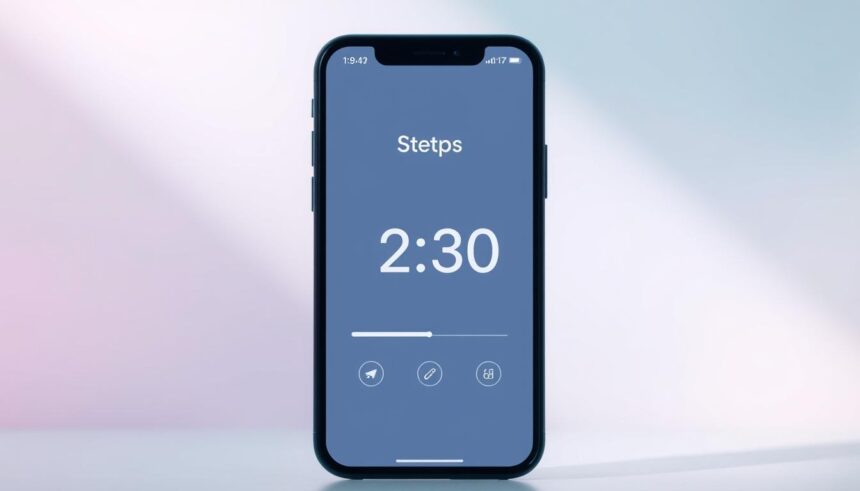You’re on a mission to shed those extra pounds, and you’re wondering how many steps you need to take daily to achieve your weight loss goal. You’re not alone in this journey.
Many people are turning to walking as a simple and effective way to lose weight and improve overall health. Walking is an accessible form of exercise that can be done by anyone, anywhere.
By understanding the science behind walking and weight loss, you can create a personalized walking plan that suits your needs and helps you reach your goals.
Key Takeaways
- Walking is a simple and effective way to lose weight.
- A daily step count can help you track your progress.
- Setting realistic goals is key for a successful weight loss journey.
- A consistent walking routine can lead to sustainable weight loss.
- Combining walking with a balanced diet can enhance weight loss results.
The Science Behind Walking and Weight Loss
Walking is a simple yet powerful tool for weight loss. But what’s the science behind it? When you walk, you’re not just moving your body. You’re creating a cascade of physiological responses that can help you shed pounds.
How Walking Creates a Calorie Deficit
Walking helps you lose weight by creating a calorie deficit. This happens when you burn more calories than you consume. The more you walk, the more calories you burn.
For example, a 30-minute brisk walk can burn about 150-200 calories. This depends on your pace and weight.
The Metabolic Benefits of Regular Walking
Regular walking not only burns calories during the activity. It also has long-term metabolic benefits. It can increase your resting metabolic rate (RMR), meaning your body burns more calories at rest.
This effect can last for several hours after your walk.
Walking vs. Other Forms of Exercise for Weight Loss
So, how does walking compare to other forms of exercise for weight loss? Walking is a low-impact activity that’s easy on the joints. It’s accessible to most people.
While high-intensity exercises like running or HIIT (High-Intensity Interval Training) can burn more calories in less time. Walking is a sustainable, long-term option for many. A study comparing different exercise types found that walking, when done consistently, can be just as effective for weight loss as more intense forms of exercise.
To maximize weight loss through walking, consider incorporating interval training or walking uphill. This can boost calorie burn. Also, combining walking with a balanced diet will enhance your weight loss efforts.
Understanding the 10,000 Steps Benchmark

Have you ever wondered where the 10,000 steps a day idea came from? This number is often seen as a key to a healthier life. But, let’s look into its origins and if it really works.
Origin of the 10,000 Steps Recommendation
In Japan, the 1960s saw a marketing push for a pedometer called the “Manpo-kei.” It was called a “10,000-step meter.” This was more of a marketing idea than a science-backed figure.
Is 10,000 Steps Scientifically Supported?
Even though 10,000 steps might not be scientifically proven, the idea of encouraging more walking is good. Studies show walking can help with weight loss, heart health, and lower disease risks.
Why One Size Doesn’t Fit All
It’s important to remember that the right number of steps for weight loss varies. It depends on age, fitness, and health. A tailored approach to step goals might be better for losing weight and improving health.
How Many Steps a Day to Lose Weight: The Research
Studies show that daily steps can greatly affect weight loss. Recent research has given us more insight into how steps relate to losing weight. This information is helpful for those trying to lose pounds.
Recent Studies on Step Count and Weight Loss
Many studies have looked into the best step count for losing weight. A key study in the Journal of the American Medical Association found that 7,000 to 8,000 steps daily can help a lot with weight loss. Another study said 10,000 steps is a good target, but how hard you walk matters too.
Optimal Step Ranges for Different Weight Loss Goals
The right number of steps depends on your weight loss goals. For a moderate goal, try for 8,000 to 10,000 steps each day. If you want to lose more weight, you might need 12,000 steps or more.
| Weight Loss Goal | Daily Step Count |
|---|---|
| Moderate Weight Loss | 8,000 – 10,000 steps |
| Significant Weight Loss | 12,000+ steps |
Step Count Recommendations by Age and Fitness Level
Step count advice changes with age and fitness level. Older or less fit people might start with 5,000 to 7,000 steps and then increase. Younger, more active people might aim for 10,000 steps from the start.
Knowing these guidelines can help you make a walking plan that fits your needs and goals. This way, you can make your weight loss journey more effective.
Calculating Your Personal Step Goal
![]()
Now that you know how walking helps with weight loss, it’s time to set a step goal that fits you. To do this, you need to think about a few things that affect your daily steps.
Assessing Your Current Activity Level
Start by tracking your daily steps for a week to see your baseline activity. Use a pedometer, fitness tracker, or a smartphone app to keep track. This will show you your daily habits and help you spot any patterns or changes in your activity.
Setting Realistic Step Targets Based on Your Lifestyle
When setting your step goal, think about your lifestyle, schedule, and what you like. If you’re new to walking, start with a goal you can reach and then increase it. For example, if you’re currently walking 5,000 steps a day, aim to walk 7,000 steps in a few weeks. Setting realistic targets keeps you motivated and consistent.
Adjusting Goals for Health Conditions and Limitations
If you have health issues or physical limitations, adjust your step goals. Talk to your healthcare provider to find a safe and effective target. For example, if you have mobility problems, try shorter walks more often. Being flexible and adapting your goals to your needs is key for success.
By setting a step goal that’s right for you, you’ll be more likely to keep up with your walking plan and reach your weight loss goals.
Creating a Progressive Walking Plan
Creating a progressive walking plan is key to losing weight through walking. You need a plan that gets harder as you go. This will help you reach your weight loss goals.
Starting with Achievable Goals
First, find out how many steps you take each day. Then, set a goal that’s a bit higher. For many, this means adding 1,000 to 2,000 steps to your usual count.
Weekly Incremental Increases
After setting your goals, plan to increase your steps each week. Aim for 500 to 1,000 more steps each week. This slow increase helps your body adjust without getting hurt or tired.
Plateau Strategies
When you hit a plateau, don’t worry. You can change your walking plan to get past it. Try making your walks more intense or longer.
When to Increase Intensity
If you’ve been walking the same pace for weeks, it’s time to try something new. Add brisk walks, hills, or stairs to your routine. This will challenge you and help you lose more weight.
When to Increase Duration
Or, you can walk for longer. Add more time to your daily walks or do longer walks on weekends. This will also help you lose weight.
By following these tips and adjusting your plan as needed, you can keep losing weight. Keep up the good work!
Step Intensity Matters: Walking Quality vs. Quantity
Counting steps is key, but how fast and how steep you walk matters too. It’s not just about the number of steps. It’s also about how you walk them.
The Impact of Walking Speed and Incline
Your walking speed and the incline can greatly affect calorie burn. Brisk walking burns more calories than slow walking. Adding hills to your route can also increase calorie burn.
Incorporating Interval Walking
Interval walking means switching between fast and slow walks. This method boosts calorie burn and improves heart health.
Heart Rate Zones for Optimal Fat Burning
Knowing your heart rate zones helps you burn fat better. Walking at 60-70% of your max heart rate burns more fat.
To lose weight, balance your steps with walking intensity. Using these tips in your walks can help you reach your weight loss goals.
Tracking Your Steps Effectively
To reach your weight loss goals, tracking your steps is key. You need to pick the right tools and know how to use the data they give you.
Best Step Counting Devices and Apps
Many devices and apps can track your steps well. Fitbit and Garmin are popular fitness trackers. Google Fit and Apple Health are top smartphone apps.
When picking a device or app, look at accuracy, ease of use, and extra features. Features like heart rate monitoring and GPS tracking are important.
How to Use Step Data to Optimize Weight Loss
With a step tracking device or app, you can improve your weight loss. Watch your daily step count and adjust your routine to hit your ideal step count for weight loss.
You can also spot patterns and trends in your walking. This helps you stay on track and move closer to your goals.
Setting Up Reminders and Challenges
To stay motivated, set up reminders and challenges in your app or device. Set daily step goals and get reminders to move. Many apps let you join challenges with friends or others.
This adds a fun social element to your walking. It helps you stay accountable and motivated.
Combining Step Goals with Dietary Changes

To really lose weight, you need to match your diet with your step goals. Walking is key, but eating right is just as important for success.
Nutrition Principles for Walking-Based Weight Loss
Eat lots of whole foods like veggies, fruits, lean meats, and whole grains. Stay away from processed foods and sugars. They can slow down your weight loss.
Meal Timing Around Your Walking Schedule
Plan your meals to fit your walks. Have a light snack before and a full breakfast after morning walks. For evening walks, eat a light meal or snack first.
Hydration Strategies for Walkers
Drinking water is vital, more so when you’re active. Drink water before, during, and after your walks to stay hydrated.
| Meal Timing | Walking Schedule | Hydration Tips |
|---|---|---|
| Light snack before morning walk | Morning walk | Drink water before, during, and after walks |
| Balanced breakfast after morning walk | Evening walk | Avoid sugary drinks |
| Light meal or snack before evening walk | Monitor urine color to check hydration |
Common Mistakes When Using Steps for Weight Loss
Walking is a great way to lose weight, but there are common mistakes to watch out for. When trying to lose weight through walking, it’s key to know the pitfalls that can stop you.
Compensatory Eating After Walking
One big mistake is eating too much after walking. You might feel hungrier after exercising, but eating more calories than you burned can undo your walk’s benefits. Be careful with your food and avoid eating too many calories.
Neglecting Strength Training
Walking is good for your heart, but ignoring strength training limits your weight loss. Adding strength exercises can help build muscle. This boosts your metabolism and helps with weight loss.
Focusing Only on Quantity, Not Quality
Just counting steps can make you lazy. Instead, focus on the quality of your walks. Try brisk walking, intervals, or inclines to burn more calories and improve your heart health.
Overcoming Common Walking Challenges
Starting your walking journey to lose weight can face many challenges. But, you’re not alone in this fight.
Weather and Seasonal Obstacles
Bad weather or changing seasons can stop your walking. To beat this, get proper gear like waterproof jackets. Or walk indoors at malls or gyms when it’s cold or rainy.
Time Constraints and Busy Schedules
Finding time to walk can be tough, with a busy life. Try to add walking to your daily routine. Walk during your lunch break or while running errands.
Motivation and Consistency Issues
Keeping motivated is key for walking success. Set reachable goals and track your steps. Also, having a walking partner or joining a group can boost your motivation.
Building a Walking Habit
Being consistent is vital to make walking a habit. Start with small goals and slowly increase your steps.
Finding Walking Buddies
Walking with someone makes it more fun and keeps you on track. Look for local walking groups or invite friends and family to join you.
| Challenge | Solution |
|---|---|
| Weather and Seasonal Obstacles | Invest in proper gear or walk indoors |
| Time Constraints and Busy Schedules | Incorporate walking into daily routine |
| Motivation and Consistency Issues | Set achievable milestones and find a walking buddy |
Incorporating More Steps Into Your Daily Routine
Making small changes to your daily routine can greatly increase your step count. You don’t need to make big changes. Just small, consistent steps can add up.
Workplace Strategies for Increased Step Count
At work, try taking the stairs instead of the elevator. Walk to a coworker’s desk instead of emailing. Or, schedule walking meetings. These simple actions can significantly boost your daily steps.
Household Activities That Boost Step Numbers
Household chores like vacuuming and mopping can help your step count. Try to be more active while doing these tasks. For example, vacuuming to your favorite music can make it more fun and increase your steps.
Social Activities That Involve Walking
Join activities that involve walking, like walking with friends or joining a walking group. Even walking while on phone calls can help. It boosts your steps and strengthens your social bonds.
Creating Step-Friendly Environments
Make your home and workplace more step-friendly. Place reminders to move, set up walking paths, or use standing desks. These changes encourage more movement throughout the day.
| Activity | Approximate Steps |
|---|---|
| 10-minute walk | 1,000-1,500 steps |
| Vacuuming a room | 100-200 steps |
| Gardening for 30 minutes | 1,500-2,000 steps |
| Walking to coworker’s desk | 20-50 steps |
By adding these strategies to your daily life, you can meet your recommended steps per day for weight loss. Every step matters. Consistent habits will help you reach your weight loss goals.
Conclusion
Now you know how walking can help with weight loss. It’s time to start your walking plan. By understanding the science, you’ve already begun your journey.
Create a walking plan that fits your life and fitness level. To lose weight, set a daily step goal that feels achievable. Studies show walking a lot is key to weight loss.
Track your steps and adjust your goal as needed. This will help you reach your fitness goals. Stay motivated by walking regularly and eating well.
With hard work and dedication, you can lose weight and stay healthy. Start walking today and set a step goal that’s realistic. Make walking a daily habit.













